Site menu:
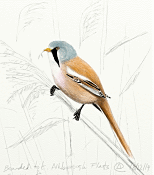
January 2019 Newsletter
Species Spotlight - Bearded Tit.
December Bird News.
Forthcoming Events.
Latest Newsletter.
Species Spotlight - Bearded Tit
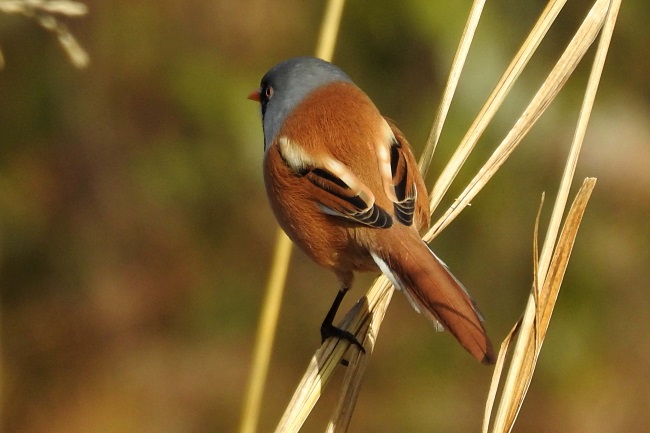
On October 23rd 2018 a Bearded Tit (Panuras
biarmicus)
was spotted at Burton Mere Wetlands - a very welcome first for the
reserve and an indication that the reed bed there was becoming fully
established. But this was far from being the first Bearded Tit recorded
on the Dee Estuary, they actually bred here for two years, so I thought
it might be of interest if I summarise the species history on the
estuary and
also describe it's status in the UK plus give some
interesting facts about this curious but undoubtedly beautiful
bird.
Bearded Tits on the Dee Estuary
1965: The first confirmed records were in 1965 when there was an unprecedented irruption of this species from East Anglia and Holland which reached the west coast of the UK. Five were observed by Ted Abraham at Shotton Pools at the end of October that year, which had increased to 16 by mid-November and some birds remained through the winter. Two of the birds, trapped at Shotton, bore Dutch rings. The only other site recording them that winter was at Burton Manor with two birds present.
1971-72: Six at Shotton.1972: Another widespread irruption across the country resulted in nine seen at Red Rocks on October 8th.
1973: Four at Red Rocks in October.
1974-75 'Present' at Shotton.
1975: One female at Red Rocks in December.
1982: One male at Neston Reedbed in April and May.
1992-93: A female present at Neston Reedbed in December and January followed by a male up until March.
2003: A pair bred in Neston Reedbed producing at least two young, present from May to November.
2004: A pair bred again at Neston Reedbed and three recently fledged young were recorded in May with birds present until November.
2005: Birds were heard calling at Neston Reedbed early in the year but there was no evidence of breeding.
2006: Two in Neston Reedbed on April 4th and 5th.2007: Three reported at Red Rocks on October 12th.
2009: A probable near Decca Pools on February 9th.
2010 A male was caught and ringed at Shotton on November 14th.
2018: One at Burton Mere Wetlands on October 23rd had increased to two by the end of the month, and to four by November 14th. Additionally the RSPB have reported that eight were photographed at Neston Reedbed on November 11th.
As you can see Bearded Tits are rare on the Dee Estuary. But they are difficult to see and no doubt some birds will have been missed over the years. Many of the records are in October and November when they disperse from their strongholds on the east coast, or even from the near continent. The breeding in 2003 and 2004 was totally unexpected with no birds recorded in the breeding season since 1982. In 2003 they were halfway through breeding before anyone realised they were there, and this was at a well watched site by a much-used footpath which shows how elusive they can be.
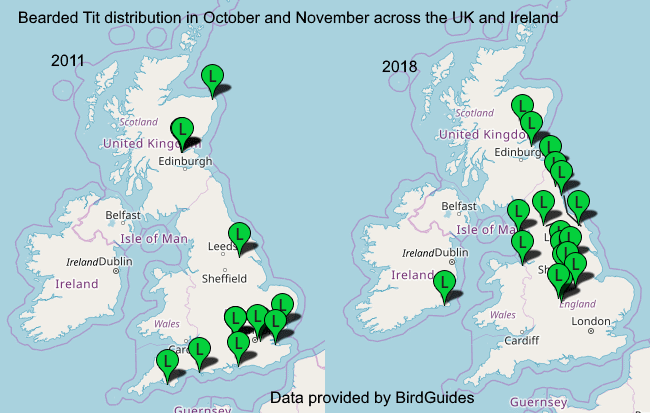
So did the 2018 autumn see another widespread influx across the country? The answer is probably not and the map of records submitted to Rare Bird Alert/BirdGuides suggests their complete absence in southern England in October and November. The 2011 map is shown for comparison demonstrating that each year is different, that year birds were virtually absent from everywhere EXCEPT southern England! Their arrival in good numbers on the Dee estuary in 2018 is probably a consequence of the general increase in numbers in the UK as shown in the graph below, and presumably a good breeding season in 2018.
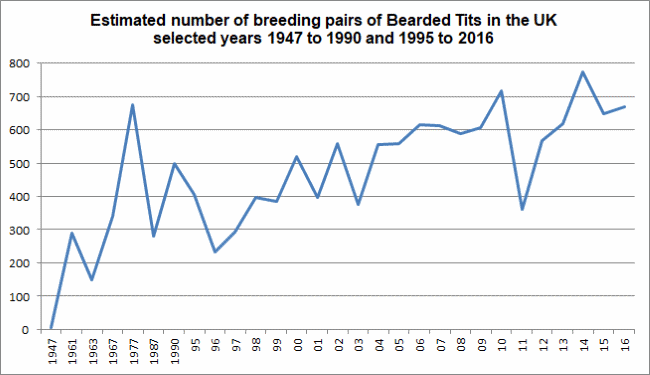 Graph
data 1947 to 1990 from Ref 9, data for 1995 to 2016 from Rare Breeding
Bird Panel Reports.
Graph
data 1947 to 1990 from Ref 9, data for 1995 to 2016 from Rare Breeding
Bird Panel Reports.
Bearded Tit Status in the UK
The exceptionally harsh winter of 1946/47 saw Bearded Tits drop to just four breeding pairs the following summer. As they don't migrate Bearded Tits are very vulnerable to cold winters and each dip in breeding numbers shown in the graph above is a result of one. But they are able to recover remarkably quickly as they can have up to four broods a year and numbers had increased to almost 300 pairs before another cold winter in 1962/63. Again they recovered quickly to 675 pairs in 1977 before a big fall to just 232 pairs in 1996 - a combination of loss of habitat and yet another cold winter. From that there has been a fairly steady increase except for a severe drop after the winter of 2010/11. A quick recovery from that winter resulted in the highest ever number of breeding birds recorded so far - 772 pairs in 2014. That year 194 pairs were estimated to be breeding in the Tay reed beds in north-east Scotland, thus becoming the most important site in the country for this species. They only started to breed here in the early 1990s so that was a fantastic total, the only trouble is is that the reed beds there are so large it's almost possible to count the birds with any great accuracy so pairs are estimated from ringing returns.
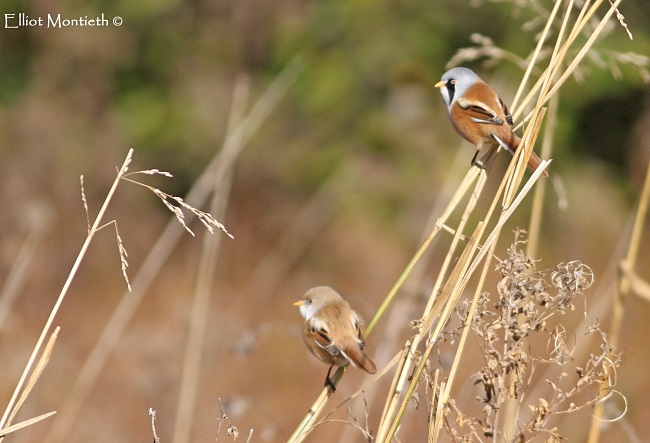
Bearded Tits - some interesting facts
a) Bearded Tits were originally called 'tits' because of their superficial similarity to Long-tailed Tits, but recent research has shown that no other living species seems to be particularly closely related and it is now placed in the monotypic family Panuridae. Therefore it's alternative name, Bearded Reedling, is perhaps more appropriate.
b) Bearded Tits don't migrate but they do undergo a distinct dispersal in the autumn prior to which they undergo a strange 'High Flying' ritual, I quote Dominic Cousins (Ref 10):
Groups of mixed adults and juveniles first make excited call notes within the reeds and, sufficiently rallied, they suddenly rise steeply as one into the air up as high as 60 metres. Here, strengthened by continuous calling, they fly to and fro above their swampland home for a few minutes before cascading down again. This behaviour may be repeated many times in a day and for some weeks during the autumn. Eventually, especially in late October, smaller parties will indulge in one more High Flying exercise and, rather than falling back as usual, actually fly away and out of sight, their destination another reed bed many kilometres, sometimes hundreds of kilometres, away.
c) Bearded Tits have a very big range being found in temperate regions right across Europe and Asia, but because of their restricted habitat of extensive reed beds they are never very numerous and their distribution is patchy.
d) Bearded Tits feed on insects in the summer but in winter they eat reed seeds, in order to digest the latter their intestines expand in size and they ingest hundreds of small stones which are excreted the following spring. In order to eat the seeds they need plenty of water which is why they are hard hit when this is frozen.
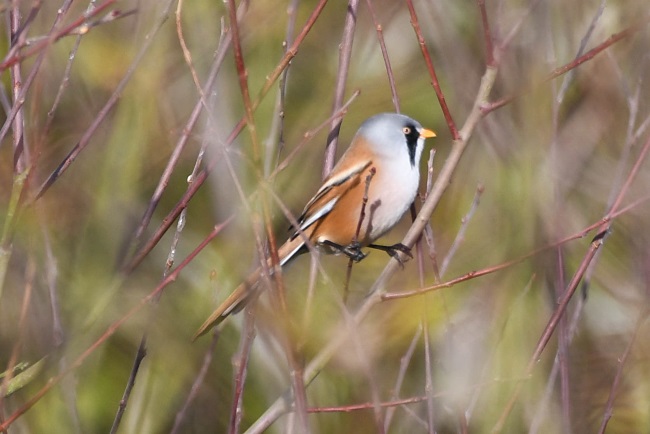
References
1. Colin Wells, Bearded Tit Breeding: A first for Cheshire, Cheshire and Wirral Bird Report 2003 (CAWOS).
2. T. Hedley Bell, A supplement to The Birds of Cheshire, Sherratt, 1967 (The Birds of Cheshire published in 1962).
3. David Norman on behalf of CAWOS, Birds in Cheshire and Wirral (A Breeding and Wintering Atlas), 2008.
4. Roger Lovegrove, Iolo Williams and Graham Williams, Birds in Wales, T&AD Poyser, 1994.5. Peter Coffey (Merseyside Ringing Group) Pers. Comm. re records from Shotton (November 2018).
6. RSPB Dee Estuary (Graham Jones) via Wirral Birders WhatsApp Group.
7. Birds of the Western Palearctic, BWPi 2.0 (2004-2006), BirdGuides.
8. Rare Bird Breeding Panel Reports
published in British Birds, also available at:
https://www.rbbp.org.uk/rbbp-reports.htm.
9. Lennox Campbell, John Cayford and David Pearson, Bearded Tits in Britain and Ireland Brit. Birds 89: 335-346, August 1996, British Birds 1996 (an official publication of the RSPB Research Department).
10. Dominic Cousins, Bearded
Tit Panuras
biarmicus, see
http://www.birdwords.co.uk/bird-factsheets/bearded-tit-panurus-biarmicus/
11. Cheshire and Wirral Bird Reports - various (CAWOS).
Note: Sketch of Bearded Tit above by
Africa Gomez ( see http://abugblog.blogspot.com/ and
https://birdsketches.wordpress.com/).
Top of Page
December Bird News
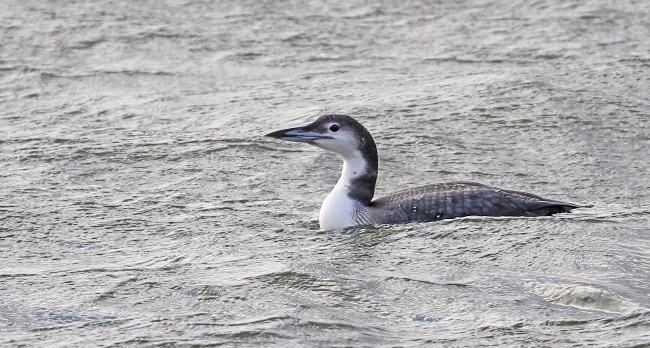
The Great Northern Diver which arrived at the end of last month stayed another two weeks giving great views and photo opportunities. A Swift was well seen over West Kirby on the 1st, you might think this is an unlikely record but given almost continuous strong southerly and south-east winds for several weeks prior to it's arrival it was not totally unexpected. Late records aren't as unusual for this species as you might think and there have been several November records for Cheshire and Wirral over the years including one on November 28th 1994 at Rivacre LNR. There was also a 'possible' one at Lymm on December 2nd 1949, seemingly only dismissed due to it's late date (dates kindly supplied by Steve Barber). But there remains a strong possibility that this was in fact a Pallid Swift of which there was an unprecedented influx into the country in November, this species is quite dark in winter making them a bit of a challenge to differentiate from our normal Common Swift.
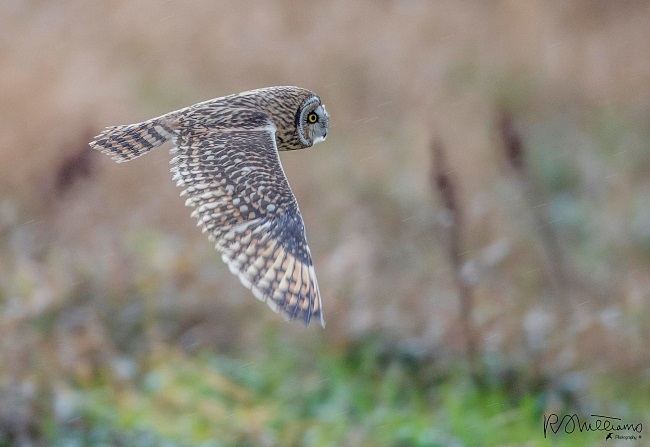
Short-eared Owls have been a bit thin on the ground so far this winter
but there have been a few, including a couple at Parkgate giving great
views. This is the best winter for Harriers I can remember with seven
Hen Harriers and the numerous reports of Marsh Harriers suggesting
numbers are well into double figures. Another species in double figures
are Great Egrets and a record count of 18 were seen flying past Neston
Reed Bed to roost at Burton on the 21st. There is still at least one
Bittern over-wintering, seen several times at Neston reed-bed.

Pink-footed Geese continue to feed in coastal fields with at least
2,500 or so in the Heswall, Irby, Greasby and Meols area, and there
were reports of over 5,000, perhaps as many as 10,000, feeding in
fields north-east of Chester and seen flying back to the estuary late
afternoon. As seems to be the norm in recent winters Brent Geese have
become quite scattered so difficult to count but numbers at Hilbre have
been well over 200 with smaller flocks at West Kirby, Thurstaston and
Heswall. Duck numbers remain high including 6,000 Wigeon and 2,000
Pintail off Oakenholt Marsh. Thurstaston and Heswall is one of the best
places to get good views of Pintail and Teal with 730 of the former and
800 of the latter this month. Large numbers of Cormorants are again
roosting in the estuary overnight and seen flying out into Liverpool
Bay at dawn - max 1,610.
One or two Bearded Tits are still at Burton Mere Wetlands and single Black Redstarts were at Gronant and Shotwick Lake. A Firecrest was briefly spotted at Riverbank Road, Heswall.
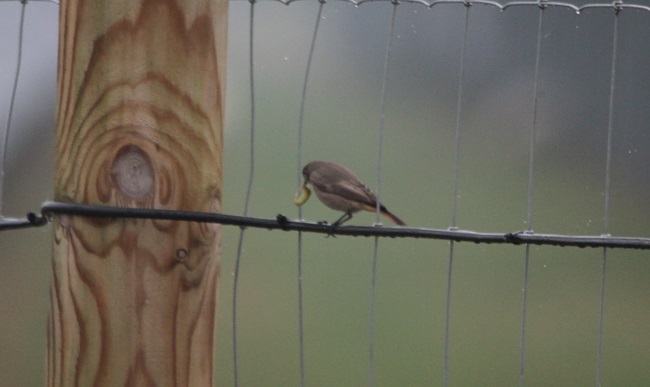
Top of Page
What to expect in January
There are some good high tides in the third week of January, if there is a fresh westerly wind this should be enough to cover the marshes and we can get fabulous views of Short-eared Owls, Marsh and Hen Harriers, Water Rails and Pink-footed Geese. That will also bring Purple Sandpipers into the roost on New Brighton Marine Lake and we hope for numbers well into double-figures along with a few hundred Redshanks and Turnstones.
Top of Page
Forthcoming Events
January Highest Spring Tides (Liverpool)
Also see Tides page.
22nd January, 11.48hrs (GMT),
9.9m.
23rd January, 12.36hrs (GMT), 10.0m.
24th January, 13.23hrs (GMT),
9.9m.
25th January, 14.09hrs (GMT),
9.7m.
Forthcoming Events
Organised by the Wirral Ranger Service , Flintshire Countryside Service and the RSPB (Dee Estuary): All these events and walks have bird interest, even those not advertised specifically for birdwatching. No need to book for these events unless specified - please check below.
Sunday 13th January - Raptorwatch at Parkgate (RSPB).
1pm-dusk, Price: Free.
Join us for a chance to see up to seven different birds of prey including peregrine and merlin, plus two types of owl that all make their home on the RSPB Dee Estuary nature reserve. With its panoramic views of the saltmarsh, Parkgate is one of the best places to watch for these birds hunting.
Stick around until dusk for a chance to see the graceful and endangered hen harriers flying into roost for the night on the marsh close to the Old Baths car park, and maybe a ghostly barn owl emerging to hunt. No booking required, come along any time between 1pm and sunset.
Dress appropriately for the weather and don't forget your binoculars! Public toilets and various pubs and cafes are situated close by along Parkgate promenade.
Wednesday 23rd January - Parkgate Hightide Birdwatch (RSPB).
10.30am-2.30pm, Price: Free.
In celebration of the RSPB Dee Estuary reserve's 40th anniversary, join us at Parkgate Old Baths for the awe-inspiring spectacle of a high tide flooding the vast saltmarsh, potentially reaching the old sea wall. The marsh at Parkgate is one of the best wetland habitats in the northwest, and when flooded by an incoming tide, the wildlife which lives here is pushed closer, with chance of seeing the great range of ducks, geese, wading birds and egrets in big numbers as they are driven upstream by the rising tide. A range of birds of prey take advantage of mice and voles flushed from the grasses; hen and marsh harriers, peregrines and merlins all spend the winter months on the estuary and this is one of the best places to watch them, plus short-eared owls if we're really lucky. So why not venture out to try witness all the drama. Low pressure and a westerly wind will help push the tide and wildlife in close. There is free public parking at the Old Baths car park (CH64 6RN) at the north end of The Parade, and the Wirral Country Park car park on Station Road (CH64 6QJ). There are public toilets at Mostyn Square in the middle of The Parade, and a number of pubs and cafes. High tide (10.0m/32.8ft) at 12.36pm.
Sunday 10th February - Raptorwatch at Parkgate (RSPB).
1pm-dusk, Price: Free.
Join us for a chance to see up to seven different birds of prey including peregrine and merlin, plus two types of owl that all make their home on the RSPB Dee Estuary nature reserve. With its panoramic views of the saltmarsh, Parkgate is one of the best places to watch for these birds hunting.
Stick around until dusk for a chance to see the graceful and endangered hen harriers flying into roost for the night on the marsh close to the Old Baths car park, and maybe a ghostly barn owl emerging to hunt. No booking required, come along any time between 1pm and sunset.
Dress appropriately for the weather and don't forget your binoculars! Public toilets and various pubs and cafes are situated close by along Parkgate promenade.
Sunday 10th March - Raptorwatch at Parkgate (RSPB).
1pm-dusk, Price: Free.
Join us for a chance to see up to seven different birds of prey including peregrine and merlin, plus two types of owl that all make their home on the RSPB Dee Estuary nature reserve. With its panoramic views of the saltmarsh, Parkgate is one of the best places to watch for these birds hunting.
Stick around until dusk for a chance to see the graceful and endangered hen harriers flying into roost for the night on the marsh close to the Old Baths car park, and maybe a ghostly barn owl emerging to hunt. No booking required, come along any time between 1pm and sunset.
Dress appropriately for the weather and don't forget your binoculars! Public toilets and various pubs and cafes are situated close by along Parkgate promenade.